Does Regenerative Agriculture offer an opportunity for marketing?
Context
The global agri-food system’s contribution to climate change and biodiversity loss is important, and it is among the industry’s most adversely affected by these ecological crises. In Europe the economic, social, and regulatory pressure on the agriculture system is especially intense. Agriculture contributes in Europe for approx 10% of absolute greenhouse gas (GHG) emissions.
And when looking into the GHG emissions per unit of food products, agriculture is almost always part of the supply chain (so called scope 3 emissions up & downstream (1)) and represents approx 80% of total emissions.

On the other hand farmers must cope with the increasing intensity and frequency of extreme weather events—in the form both of droughts and of rains, impacting the crops yields, even as they struggle to meet the increased cost of land and farming inputs.
And meanwhile, regulators are imposing limits on GHG emissions (Farm to Fork & Green Deal) and requiring changes in land use while consumers are demanding more transparancy, more healthier and affordable food.
The pressure on farming is heating up
Farmers are facing an increasing number of challenges: from rising input costs over climate changes, more regulatory & societal pressure.
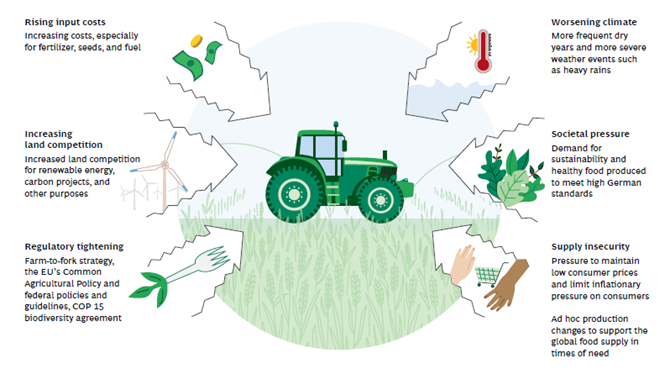
Source: https://www.bcg.com/publications/2023/regenerative-agriculture-benefits-germany-beyond
What is regenerative agriculture?
There are many different definitions of regenerative agriculture. But summarized: Regenerative Agriculture is an outcome-based farming approach focussing on protecting and improving soil health, biodiversity, water & climate resources while ensuring the farm overall productivity and profitability and contributing to defend the future of family farming.
A few important aspects in this definition.
- Regenerative Agriculture is not a ‘one size-fits-all-solution’ approach. It depends much on the specific context, such a soil health and climatological circumstances
- Regenerative agriculture not only leads to climate benefits, but also addresses socio-economic objectives by improving farm resilience and profitability over the longer term.
- CO2 reduction or removals are a result of these reg. ag. farming practices
- It should contribute to securing the supply of agricultural raw materials in appropriate quality and quantity
It’s part of sustainable farming in general. Farmers already take quite some initiatives to improve soil health such as implementing a crop rotation or application of cover crops (2).
The difference lies however in the fact that it’s an outcome based approach, focussing on specific outcomes such as reduction of fertilizer or measuring the impact on carbon sequestration, together with a continous improvement through innovation & adoption. And it’s this transition that creates a challenge, since farmers want to manage the risks and cost of transition.
For more info on sustainable farming standards, please check https://saiplatform.org/fsa/
SAI developed a crop agnostic standard, referring to farming practices that consist out of different environmental and social criteria, but practice based.
The best way for a marketer to understand what is behind these definitions, is to go in the field and talk to farmers directly.
What is the difference with organic farming
Organic farming & regenerative farming are 2 distinct approaches, both emphasizing sustainability & environmental stewardship.
Organic farming is an agricultural system that focusses on minimizing the use of synthetic inputs such as pesticides & fertilizers. The main goal is to produce food & ingredients while maintaining soil health & biodiversity. This often leads to output reduction.
Regenerative farming aims to improve the overall health & resilience of the entire ecosystem, while keeping the output/ha at the same level compared to conventional farming.
What is the consumer interest?
Organic farming & regenerative farming are 2 distinct approaches, both emphasizing sustainability & environmental stewardship.
Organic farming is an agricultural system that focusses on minimizing the use of synthetic inputs such as pesticides & fertilizers. The main goal is to produce food & ingredients while maintaining soil health & biodiversity. This often leads to output reduction.
Regenerative farming aims to improve the overall health & resilience of the entire ecosystem, while keeping the output/ha at the same level compared to conventional farming.
What is the consumer interest?
To answer this question, I’m referring to a broad research conducted by my marketing colleagues of Südzucker across different countries & different food categories in 2022.
There’s an interest in sustainability, however remains for the consumer a complex, wide range topic.
Besides the omni-present aspects of reducing food waste, increasing share of recycling and less packaging in general, sustainability aspects like responsible water usage, fostering biodiversity or reduction of CO2-emissions were mentioned as very important criteria by over 60 % of consumers.
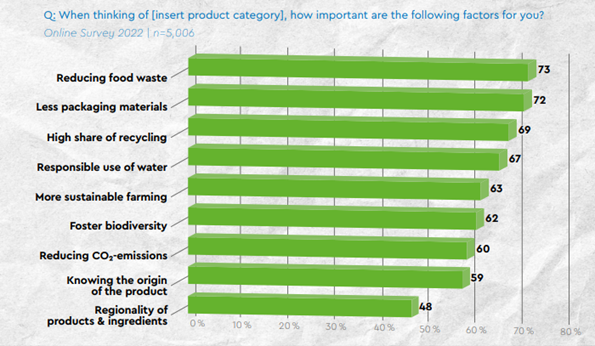
Source: https://pages.suedzucker.com/download-wp-processed-foods-and-drinks-study-2022/
Opportunities for marketing
I want to use the model as described by HBR in the article ‘Moving the needle on sustainability’ (3) for defining some opportunities.
When focussing on existing markets, it shows 2 dimensions and potential routes for marketing to apply when it comes to integrating sustainable or regenerative farming into their plans.
- Sustainability via purchase
- Sustainability via customer participation
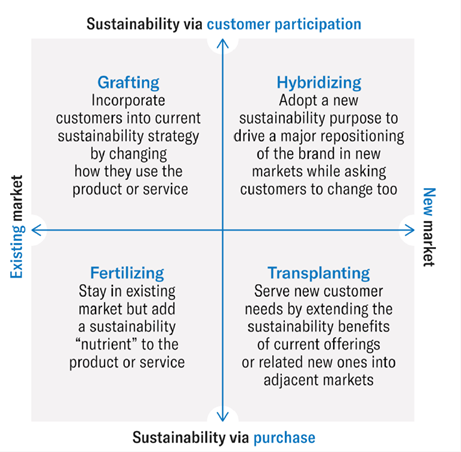
‘Sustainability via purchase’
Two inspiring examples
1. Frozen food brand Birds Eye has launched its new masterbrand platform, “An eye for good”. The platform highlights the brand’s sustainable work, in the direction of farming.
https://www.brandinginasia.com/birds-eye-launches-an-eye-for-good-focusing-on-sustainable-farming/
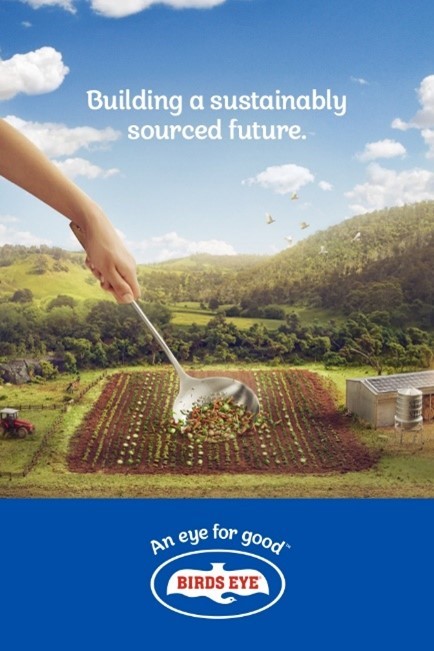
2. Lidl France explaining the regenerative practices at the basis of potato growing. This initiative was also integrated in packaging.
https://www.lidl.fr/c/producteur-de-pomme-de-terre/s10018389?ar=0&flyx=73b08343-53a4-11ed-b802-fa163e6ae2a0
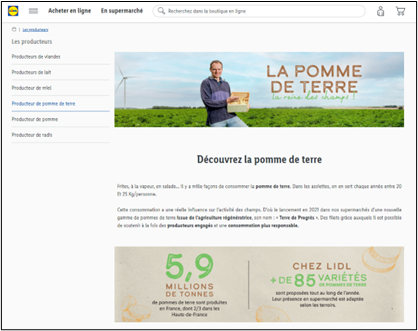
Opportunities might be more present when focussing on ‘sustainable farming’ and an integration of general farmer practices or including a testimonials. Having an active participation of consumers in supporting local farming, creates even more engagement. Key condition is to explain all in a clear & simple way.
But also in B2B, there’re opportunities
3. Barry Callebaut is teaming up with Nestlé on a large agroforestry projects. Both companies use this event within their communication strategy
https://www.barry-callebaut.com/en/group/media/news-stories/barry-callebaut-nestle-partner-agroforestry-project-cote-divoire
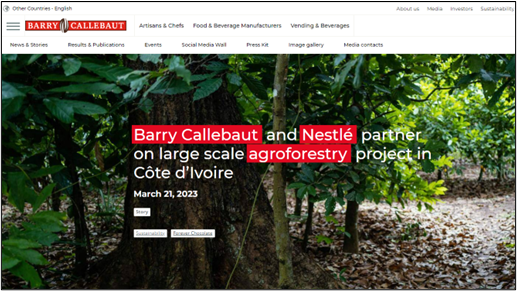
‘Sustainability via participation’
- Brewery company AB INBEV came up with the idea to partner with local farmers to go organic through supporting them by taking away the major barriers while providing consumers with meaningful ways to contribute. For every six-pack purchased of ‘Michelob ULTRA Pure Gold’, the company supported farmers to convert an additional six square feet of farmland to organic.
https://www.warc.com/content/paywall/article/Cannes/AbInbev_Contract_For_Change/en-GB/138203?
Conclusion
The case for more regenerative and climate friendly farming is clearly not only a farmers case. Support in this transition is essential and a responsibility for the total supply chain, including branded manufacturers and retailers. Regenerative farming is however a difficult concept. Talking to farmers directly will for sure help in getting a better understanding, and to be crossed with accurate understanding of consumer motivations. And his could be the basis for a meaningful integration into marketing plans.
Further interesting notes:
Further interesting notes: